In June, the migrating songbirds that pour through southern Ontario in May have largely passed through, and the birder/naturalist is free to turn his (or her) attention to the emerging summer crop of dragonflies. That means, usually, finding water. The serene, reed-lined pond in this picture (and the one above), where I took these pictures on July 7/8, 2014, is not part of a reserve but lies only a few minutes from my house, on the University of Toronto's Mississauga campus.
It's hardly the Everglades, but it does attract its share of life. The bird flying over the water's surface above, and seated on a perch here, is a Northern Rough-winged Swallow (Stelgidopteryx serripennis), dullest-plumaged of Ontario's six breeding swallows.
Much to my surprise, the pond was low in dragonflies and/or damselflies. I was only able to photograph a few of the latter. These are Bluets (Enallagma sp.), members of S large, largely American damselflies that replace, by and large, very similar-looking insects in the Old World (Coenagrion, Pseudagrion, etc). Just to keep us on our toes, there are a few Enallagmas in Europe and a few Coenagrions in North America).
Unfortunately, the only way to identify most bluets with certainty is to study their genitalia with a hand lens (something I'm not sure that I even want to do with people). About the most you can do for the tough ones is to sort them out into general categories based on how much blue there is on the abdomen). There are three or four species in southern Ontario that look very much like this one.
However, for this male I may be able to make a call. The only one of the available lot of bluet species in the area with large, widely-splayed cerci - the upper processes of the male's copulatory apparatus - is the Familiar Bluet (Enallagma civile), and I think this photo shows that feature. In the other two the genitalia seem smaller and less splayed; if so, based on habitat, they might be Northern Bluets (E. annexum), in which the cerci are quite small and the lower processes, the paraprocts, are much more obvious. However, they could also be Vernal Bluets (E. vernale) or Boreal Bluets (E. boreale); without a specimen in hand it is almost impossible to tell.
There is no such trouble with the Eastern Forktail (Ischnura verticalis). We only have two of them in our neck of the woods, and they are quite easy to tell apart. Realizing that the female (above) and male (below) are members of the same species can be a little trickier.
Juvenal's Duskywing (Erynnis juvenalis) is one of our commoner skippers.
If only to convince me that yes, this was indeed wetland habitat. a young Great Blue Heron (Ardea herodias) dropped by...
There is no such trouble with the Eastern Forktail (Ischnura verticalis). We only have two of them in our neck of the woods, and they are quite easy to tell apart. Realizing that the female (above) and male (below) are members of the same species can be a little trickier.
Juvenal's Duskywing (Erynnis juvenalis) is one of our commoner skippers.
If only to convince me that yes, this was indeed wetland habitat. a young Great Blue Heron (Ardea herodias) dropped by...
...only to fly off to, perhaps, a more-fish-laden venue elsewhere.
Rocks and flowing water: a quite different wetland habitat. It is now a few weeks later, on June 23, 2014, and we are in the banks of the Credit River near my home, being serenaded (if you can call it that) by a male Red-winged Blackbird (Agelaius phoeniceus).
In the river itself are schools of Shiner (Notropis sp.), among the abundant little minnows that swarm in Ontario streams. There are a number of similar species, and I'm not sure which one this is.
A Green Frog (Lithobates clamitans) lounges in a quiet backwater.
The common damselfly here is the Powdered Dancer (Argia moesta). Their preferred habitat is a river with rocky banks.
The rocky banks of the Credit are mostly the result of people putting them there, but the damselflies don't seem to mind as long as they can sit and, presumably, sun themselves on the rocks. This one appears to be whiling away the time blowing bubbles (I wonder what it is really doing?).
Young female Powdered Dancers are mostly brown and black.
As the sexes age they become more pruinose - that is, covered in a pale powder (hence the name).
We came across several joined pairs in the course of our walk. This is probably not mating, but oviposition after mating has been completed. Powdered Dancers lay their eggs on stream vegetation, while the male stays in contact with her in case a male with other ideas happens by.
Some of the pairs were, in fact, would-be trios, with a rival male waiting to horn in.
Sometimes the rivals didn't bother to wait. This one seems to be trying, without much success, to dislodge the male.
Finally, though, he gave up, and left the courting couple to get on with their affairs in peace. These do seem about to mate; the female appears to be curling her abdomen forward to pick up sperm from the male's secondary genitalia.
The female Emerald Spreadwing (Lestes dryas) is one of the stubbier-looking of its genus, but it is attractively coloured in iridescent green. It is an extremely wide-ranging species, the only one of its genus to be found in both the Old and New Worlds: besides its North American range, it occurs across much of temperate Europe and Asia.
We found a male Common Whitetail (Plathemis lydia) perched on a stem...
While a female flew over the river's surface, depositing her eggs in the water.
Our chief excitement in June, dragonflies aside, was a visit from Eileen's Aunt Freda and Uncle Roland. As they are both proudly Sarawakian, we decided to use the occasion for a drive north to Georgian Bluffs, just north of Owen Sound, on June 27, 2014. Georgian Bluffs is a recent amalgamation of three former municipalities, one of them known until the amalgamation as Sarawak, Ontario. This may sound extremely odd, but the town owes its former name to a former Governor General of Upper Canada (as Ontario was then called) who was an uncle of James Brooke, the first White Rajah of Sarawak. Though he seems to have been under the impression that Sarawak was in India, he wanted to commemorate his nephew's exploits - hence, Sarawak, Ontario (a bit of history apparently unknown to its residents, but unearthed by Lim Kian Hock, an indefatigable historical researcher from Kuching). Though Sarawak, Ontario, has vanished from the maps, the name lingers on about the area, here we are at the Sarawak United Church, flanking Deborah Murray, its (then) rector...
And here is how the church looked back when Sarawak, Ontario was still Sarawak.
We added some natural scenery to our excursion by stopping at Inglis Falls, an 18-metre-high waterfall in a Conservation Area of the same name near Owen Sound.
It's a scenic (and highly photographable) spot, as Eileen would surely tell you.
The moist edges of the river were ideal for Canada Anemone (Anemone canadensis), one of our commoner spring wildflowers.
I had hoped for a few dragonflies, particularly gomphids, but the only one I saw was the individual in this poor photograph of an insect in the parking lot. I flew off before I could get another shot, but I think it could be a Lancet Clubtail (Gomphus exilis), one of our commoner species.
I did better, though, with damselflies, in a reedbed along a quiet stretch of river above the falls.
Here I found my first River Jewelwing (Calopteryx aequabilis), the less common of our two native Calopteryx (the other, the Ebony Jewelwing (C. maculata), has broader, entirely-black wings). This one, with its emerald-green body and black-tipped wings, is a male.
This one, with its shining white stigmas, is a female.
On the way back to the others I found this peculiar insect clinging to a reed. It is a Dark Fishfly (Nigronia fasciata), a member of the dobsonfly family (Corydalidae). Like dragonflies, fishflies spend their larval lives as underwater carnivores, sometimes for two or three years. Once they emerge as adults, though, they may not feed at all, and usually live for only about ten days or so.
As I emerged back onto the lawn near the parking lot I came across an American Robin (Turdus migratorius) sunning itself on the grass - a dooryard bird I was soon to leave behind as Eileen and I headed for Singapore.
It was only a few days later, on July 2, 2014, that we found ourselves at the airport, with Davin seeing us off and Freda and Roland left to their own devices at home. If you read my last post you will know what came next - at least from a naturalists' point of view - and with that, we can now return to our proper chronological sequence.
The rocky banks of the Credit are mostly the result of people putting them there, but the damselflies don't seem to mind as long as they can sit and, presumably, sun themselves on the rocks. This one appears to be whiling away the time blowing bubbles (I wonder what it is really doing?).
Young female Powdered Dancers are mostly brown and black.
As the sexes age they become more pruinose - that is, covered in a pale powder (hence the name).
We came across several joined pairs in the course of our walk. This is probably not mating, but oviposition after mating has been completed. Powdered Dancers lay their eggs on stream vegetation, while the male stays in contact with her in case a male with other ideas happens by.
Some of the pairs were, in fact, would-be trios, with a rival male waiting to horn in.
Sometimes the rivals didn't bother to wait. This one seems to be trying, without much success, to dislodge the male.
Finally, though, he gave up, and left the courting couple to get on with their affairs in peace. These do seem about to mate; the female appears to be curling her abdomen forward to pick up sperm from the male's secondary genitalia.
The female Emerald Spreadwing (Lestes dryas) is one of the stubbier-looking of its genus, but it is attractively coloured in iridescent green. It is an extremely wide-ranging species, the only one of its genus to be found in both the Old and New Worlds: besides its North American range, it occurs across much of temperate Europe and Asia.
We found a male Common Whitetail (Plathemis lydia) perched on a stem...
While a female flew over the river's surface, depositing her eggs in the water.
Our chief excitement in June, dragonflies aside, was a visit from Eileen's Aunt Freda and Uncle Roland. As they are both proudly Sarawakian, we decided to use the occasion for a drive north to Georgian Bluffs, just north of Owen Sound, on June 27, 2014. Georgian Bluffs is a recent amalgamation of three former municipalities, one of them known until the amalgamation as Sarawak, Ontario. This may sound extremely odd, but the town owes its former name to a former Governor General of Upper Canada (as Ontario was then called) who was an uncle of James Brooke, the first White Rajah of Sarawak. Though he seems to have been under the impression that Sarawak was in India, he wanted to commemorate his nephew's exploits - hence, Sarawak, Ontario (a bit of history apparently unknown to its residents, but unearthed by Lim Kian Hock, an indefatigable historical researcher from Kuching). Though Sarawak, Ontario, has vanished from the maps, the name lingers on about the area, here we are at the Sarawak United Church, flanking Deborah Murray, its (then) rector...
And here is how the church looked back when Sarawak, Ontario was still Sarawak.
We added some natural scenery to our excursion by stopping at Inglis Falls, an 18-metre-high waterfall in a Conservation Area of the same name near Owen Sound.
It's a scenic (and highly photographable) spot, as Eileen would surely tell you.
The moist edges of the river were ideal for Canada Anemone (Anemone canadensis), one of our commoner spring wildflowers.
I had hoped for a few dragonflies, particularly gomphids, but the only one I saw was the individual in this poor photograph of an insect in the parking lot. I flew off before I could get another shot, but I think it could be a Lancet Clubtail (Gomphus exilis), one of our commoner species.
I did better, though, with damselflies, in a reedbed along a quiet stretch of river above the falls.
Here I found my first River Jewelwing (Calopteryx aequabilis), the less common of our two native Calopteryx (the other, the Ebony Jewelwing (C. maculata), has broader, entirely-black wings). This one, with its emerald-green body and black-tipped wings, is a male.
This one, with its shining white stigmas, is a female.
On the way back to the others I found this peculiar insect clinging to a reed. It is a Dark Fishfly (Nigronia fasciata), a member of the dobsonfly family (Corydalidae). Like dragonflies, fishflies spend their larval lives as underwater carnivores, sometimes for two or three years. Once they emerge as adults, though, they may not feed at all, and usually live for only about ten days or so.
As I emerged back onto the lawn near the parking lot I came across an American Robin (Turdus migratorius) sunning itself on the grass - a dooryard bird I was soon to leave behind as Eileen and I headed for Singapore.
It was only a few days later, on July 2, 2014, that we found ourselves at the airport, with Davin seeing us off and Freda and Roland left to their own devices at home. If you read my last post you will know what came next - at least from a naturalists' point of view - and with that, we can now return to our proper chronological sequence.





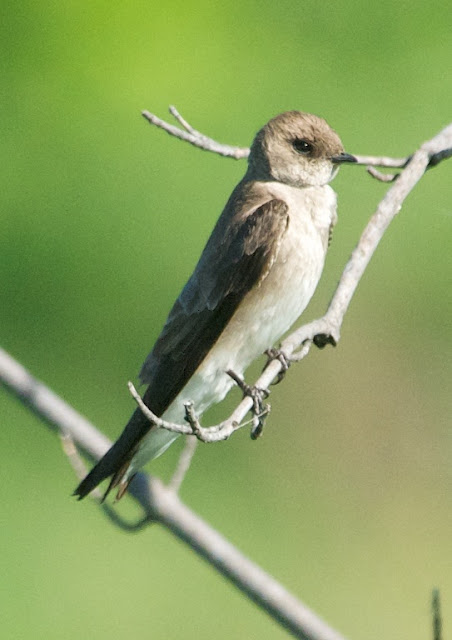
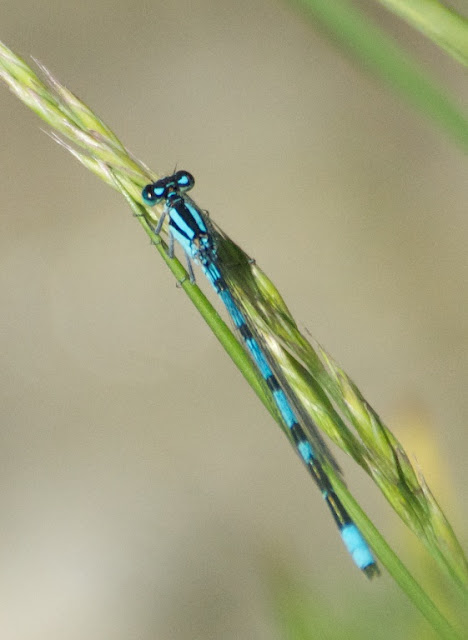













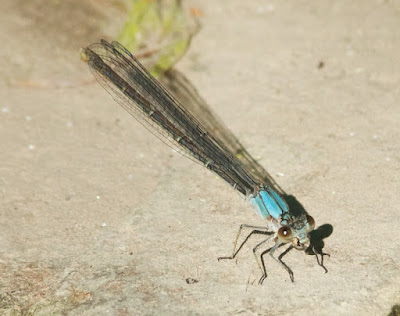

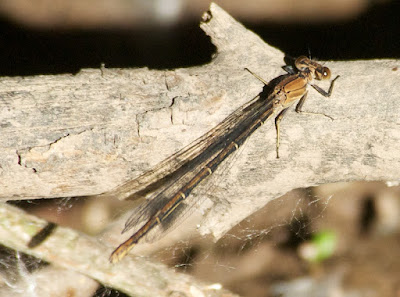





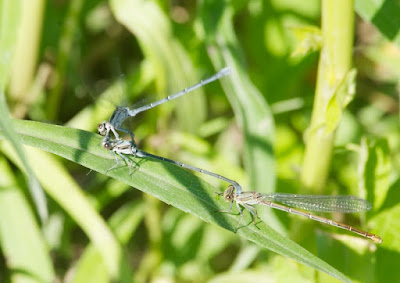
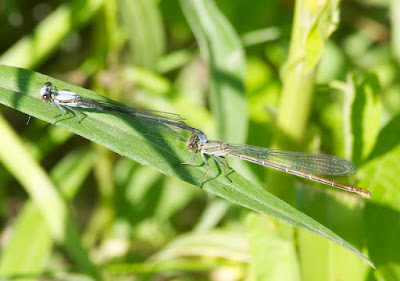





















No comments:
Post a Comment